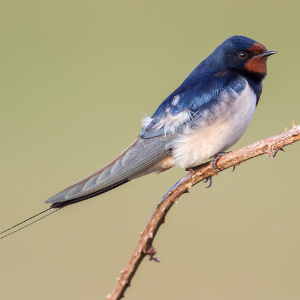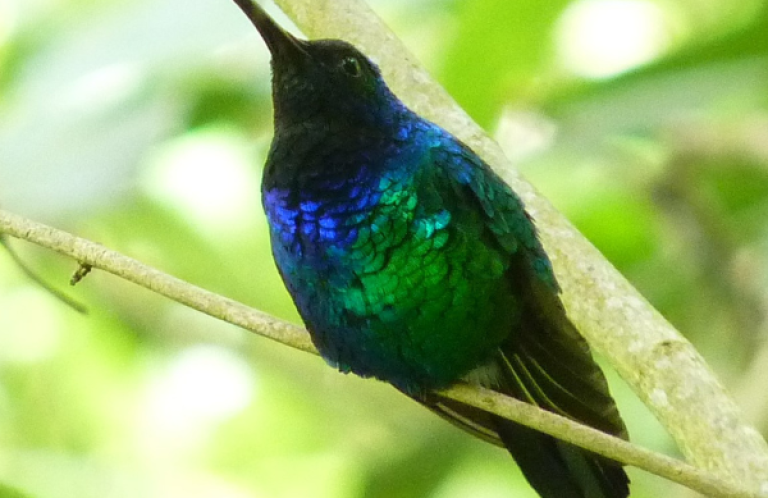Discovery of Critically Endangered South American Bird in New Area Offers Increased Hope for Avoiding Extinction
 Royal Cinclodes at Huaytapallana Regional Conservation Area in August, 2012. Photo by Oscar J. Santander/ECOAN. |
(Washington, D.C., October 12, 2012) A new discovery by the Peruvian environmental group Asociación Ecosistemas Andinos (ECOAN), of a population of the critically endangered Royal Cinclodes is providing some increased hope that this bird may be able to be saved from extinction.
In August 2012, ECOAN biologists spotted a Royal Cinclodes and possibly a second bird inside the Huaytapallana Regional Conservation Area in Peru's Junín department (comparable to a U.S. state). This sighting was 29 miles north of the nearest and previously northernmost population discovered in Junín in 2008.
“There may well be fewer than 250 of these birds left in existence,”said Constantino Aucca Chutas, President of ECOAN. “These new sightings are therefore quite significant because they raise the odds that this rare species might be saved.”
The Royal Cinclodes is listed by the IUCN-World Conservation Union as Critically Endangered; it was recently listed as Endangered under the U.S. Endangered Species Act. The largest concentrations are found in Peru's Cusco and Apurimac departments in the south of the country, with other populations in Bolivia's department of La Paz, close to the Peru border, and elsewhere in Peru's Puno and Ayacucho departments. (To see a map of the area, go to: maps.google.com and then search on “Area de Conservacion Regional Huaytapallana, Junin, Perú”)
The Royal Cinclodes is about eight inches long and weighs about 1.75 ounces; it has a slightly curved bill, and is dark chocolate-brown on the body, face, and crown, with whitish throat and streaking on the breast.
The Royal Cinclodes is usually a habitat specialist, found on the moss-covered ground of Polylepis woodlands high in the Andes of southern Peru and northern Bolivia. Polylepis trees are usually gnarled in shape with evergreen foliage and dense small leaves, and often have large amounts of dead twigs hanging down from the underside of the canopy. They are also characterized by shredding, multi-layered bark. Polylepis habitat is severely threatened by local people, who harvest the trees for firewood; their grazing animals and fires inhibit the natural regeneration of these slow-growing trees. The Royal Cinclodes sightings at Huaytapallana were within a square kilometer area, with a low density of Gynoxys bushes—a genus of flowering shrub in the sunflower family.
“The recent sightings of Royal Cinclodes in Junín are significant because the Junín birds are living among rocks in mossy alpine areas lacking Polylepis trees,” said Dr. Daniel Lebbin, Conservation Biologist at American Bird Conservancy (ABC). ECOAN is ABC's Peruvian partner.
The Huaytapallana Regional Conservation Area was established in July, 2011 and spans over 55,000 acres between elevations of 14,760-18,230 feet above sea level. ECOAN intends to work with the regional government to incorporate conservation measures for the Royal Cinclodes into the Huaytapallana Regional Conservation Area's management plan. Additional searches may better determine the population size in the area and help the regional government protect the birds.
ABC has worked with ECOAN to conserve the Royal Cinclodes in southern Peru, and worked with Bolivian environmental groups Asociación Armonía and Instituto de Ecología to protect the Royal Cinclodes in Bolivia. Those efforts include:
- In the Vilcanota Mountains of the Peruvian Andes, ABC has worked with ECOAN and more than 20 communities to protect and restore threatened Polylepis woodlands for the Royal Cinclodes, White-browed Tit-Spinetail, and Ash-breasted Tit-Tyrant. The initiative has planted more than 650,000 Polylepis trees, established seven community-owned and managed Private Conservation Areas covering more than 15,500 acres, and established a $2 million endowment to aid Polylepis forest conservation in this area.
- In Bolivia, ABC has supported work by Armonía and the Instituto de Ecología to protect and restore Polylepis woodlands for the Royal Cinclodes and Ash-breasted Tit-Tyrant.
- In both Peru and Bolivia, ABC has assisted partners in providing fuel-efficient stoves to communities to reduce their demand for fuel wood and reduce pressure on habitat for endangered birds.


















































